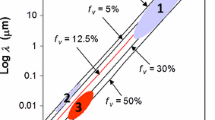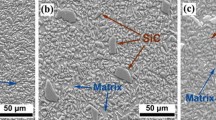Abstract
This paper proposes a fracture theory for two-phase glass-crystal composites. It is hypothesized that the fracture mechanisms of such solids consist of the processes of crack nucleation and of crack propagation round the dispersed particles. At lower volume fractions of dispersed phase, macroscopic fracture will occur as a result of the growth of the micro-cracks originating in the vicinity of the pre-existing structural imperfections through a heterogeneous nucleation process; in this case, strength decreases with the proportion of the dispersed phase. At higher volume fractions where further crack propagation is prohibited by the hard crystalline particles, the process of crack propagation round the dispersed particles may be responsible for the macroscopic fracture of the composite; in this case, strength is an increasing function of the volume fraction. Expressions are formulated for mechanical strength of the glass-crystal composites, based upon the nucleation theory and Griffith's criterion. The published data on the strength of glass-alumina composites are used for the verification of the theory. The proposed theory explains well the strength behaviour of glass-alumina composites, and in particular, the dependence of the strength reduction on particle size at lower volume fractions.
Similar content being viewed by others
References
D. B. Binns, “Science of Ceramics”, Vol. 1 edited by G. H. Stewart (Academic Press, London, 1962) p. 315.
D. P. H. Hasselman and R. M. Fulrath, J. Amer. Ceram. Soc. 49 (1966) 68.
Idem, “Ceramic Microstructure”, edited by R. M. Fulrath and J. A. Pask (John Wiley & Sons, New York, 1968) p. 343.
W. J. Frey and J. D. Mackenzie, J. Mater. Sci. 2 (1967) 124.
R. R. Tummala and A. L. Friedberg, J. Amer. Ceram. Soc. 52 (1969) 228.
R. W. Davidge and T. J. Green, J. Mater. Sci. 3 (1968) 629.
J. C. Fisher, J. Appl. Phys. 19 (1948) 1062.
T. Yokobori, J. Chem. Phys. 22 (1954) 951.
Idem, J. Phys. Soc. Japan, 10 (1955) 368.
D. Prevorsek and W. J. Lyons, J. Appl. Phys. 35 (1964) 3152.
J. N. Goodier, J. Appl. Mech. 1 (1933) 39.
D. P. H. Hasselman and R. M. Fulrath, J. Amer. Ceram. Soc. 50 (1967) 399.
R. L. Fullman, Trans. AIME 197 (1953) 447.
S. M. Wiederhorn, J. Amer. Ceram. Soc. 52 (1969) 99.
R. A. Sack, Proc. Phys. Soc. (London) 58 (1946) 729.
Author information
Authors and Affiliations
Rights and permissions
About this article
Cite this article
Miyata, N., Jinno, H. Theoretical approach to the fracture of two-phase glass-crystal composites. J Mater Sci 7, 973–982 (1972). https://doi.org/10.1007/BF00550059
Received:
Accepted:
Issue Date:
DOI: https://doi.org/10.1007/BF00550059




